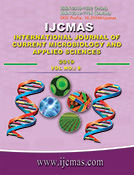


 National Academy of Agricultural Sciences (NAAS)
National Academy of Agricultural Sciences (NAAS)

|
PRINT ISSN : 2319-7692
Online ISSN : 2319-7706 Issues : 12 per year Publisher : Excellent Publishers Email : editorijcmas@gmail.com / submit@ijcmas.com Editor-in-chief: Dr.M.Prakash Index Copernicus ICV 2018: 95.39 NAAS RATING 2020: 5.38 |
Water scarcity has many negative impacts on the environment, including lakes, rivers, wetlands, and other fresh water resources. Furthermore, water shortage makes flow management in the rehabilitation of village streams problematic. Owing to poor water resource management system and climate change India faces a persistent water shortage. Indian agriculture accounts for 90% water use due to fast track ground water depletion and poor irrigation systems. Water is a critical input into agriculture in nearly all its aspects having a determining effect on the eventual yield. Adequate availability of water is important for crop and animal husbandry as well. India accounts for about 17% of the world’s population but only 4% of the world fresh water resources. Distribution of these water resources across the vast expanse of the country is also uneven. The water received is prone to runoff, seepage and percolation much faster than its uptake for crop growth. This causes potential water shortage for rainfed rice at various stages and discourages adoption of modern rice technology. Thus development of irrigation is only the solution to meet-out the food demand of ever growing population and alleviating poverty from rural area. Expansion of irrigation through major and medium irrigation systems is nearly blocked due to many reasons. Adopting minor irrigation systems has its own limitation of ultimate irrigation potential of the area. Rainwater collection in dugout small farm-pond and recycle the collected water for irrigation purposes during in-season water stresses and for establishment of post rainy season crops are found profitable approach for rainfed areas of eastern India. Large number water harvesting ponds have been created but potential benefits are not realized owing to inefficient use of harvested water. The water harvesting pond can be making effective by adoption of farming system approach along with fertigation technique. This paper reviews the current status of water availability in rainfed areas, its usage in agriculture, water smart technologies developed in agriculture and how farmer’s is attempting to move towards sustainable economy.
 |
 |
 |
 |
 |